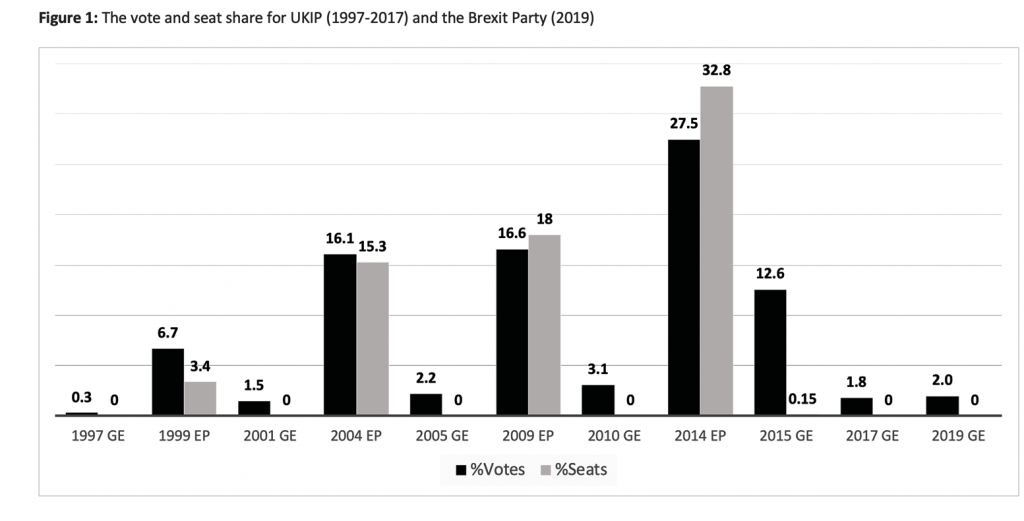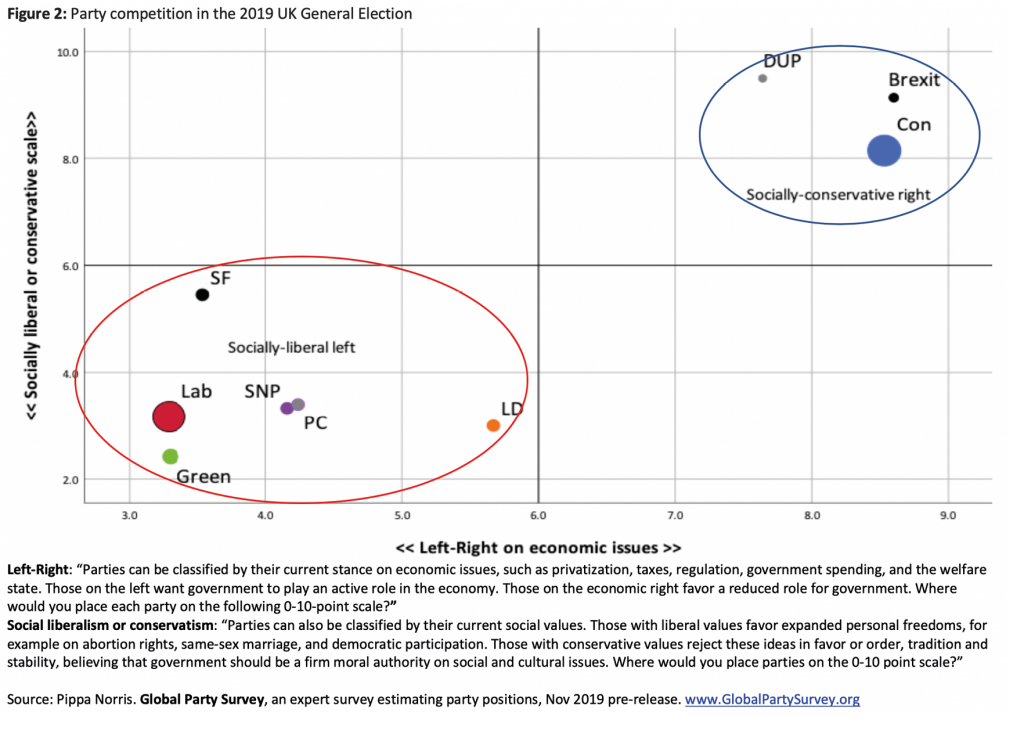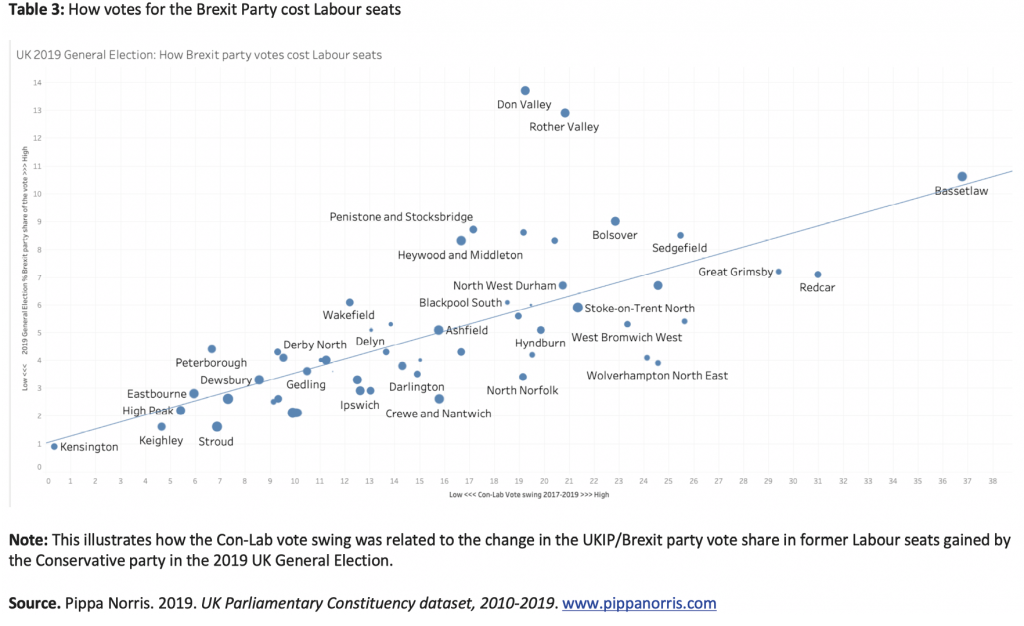
Prof Pippa Norris
Paul Macguire Lecturer in Comparative Politics at Harvard University and founding director of the Electoral Integrity Project. An international expert on comparative elections and public opinion, recent books include ‘Cultural Backlash: Trump, Brexit and Authoritarian Populism’ (with Inglehart, CUP 2019) and ‘Electoral Integrity in America’ (edited, OUP 2019).
Email: Pippa_Norris@hks.harvard.edu

Section 2: Voters, Polls and Results
- Boris’s missing women
- An expected surprise? An evaluation of polls and seat forecasts during the campaign
- Unprecedented interest or more of the same? Turnout in the 2019 election
- Cartographic perspectives of 2019 General Election
- Tactical voting advice sites
- Another election, another disappointment: Young people vote left and are left behind at GE2019
There has been relatively little discussion in the media about the Brexit Party. After all, they ended with a paltry 2.0% of the UK vote (5% in the seats they contested) and no MPs. UKIP performed even worse, with 22,817 votes (0.1%). Farage’s euroskeptic clothes, and thus rationale, were stolen by Boris Johnson. But did the Brexit Party have a greater impact on the results of the election than they gain credit for? The Conservative share of the UK vote under Johnson, after all, went up only 1.4% across the country, almost unchanged from May’s 2017 result; Johnson’s landslide victory therefore had less to do with his popularity or the strength of the Conservative campaign but a collapse in Labour’s vote. Given turnout was similar to 2017, where did this vote go?
Figure 1 illustrates how UKIP, and then the successor Brexit Party, both experienced roller-coaster rides in successive local, European and general elections. UKIP ran 378 candidates in the June 2017 general election – but won just half a million votes (1.8% of the total), with no seats. Despite this wipe-out, the major parties, especially the Conservatives, were rocked by the initial electoral success of the Brexit Party, which won the largest share of the UK national vote and seats in the May 2019 party-list European Parliamentary elections, just four months after founding. Most strikingly, the party swept up almost half of the over-65s. The opinion polls registered around 23% support for the Brexit party at their peak a few weeks later, in mid-June 2019, when they were tied or even a point or two ahead of the two major parties.
As the Leave vote was squeezed and the standing of Brexit reduced, Nigel Farage decided to play the long game by competing strategically in the election only in opposition seats, asking Brexit candidates to stand down in Conservative-held seats. This served two goals: as a brand-new party, for expedient reasons, Brexit’s financial and organizational resources were over-stretched. Moreover, the stated aim of this strategy was to present a united front which avoided splitting the Leave vote. This strategy had two consequences; the Brexit Party had opportunities to snatch Leave ballots in Labour-held seats, without simultaneously damaging the electoral prospects for incumbent Conservative MPs. At the same time, the Remain vote remained divided because Corbyn stubbornly ruled out any informal pact, despite discussions among the opposition parties, and various efforts to organize tactical voting. As Figure 2 illustrates, the Conservatives were flanked by the Brexit Party, but otherwise enjoyed ‘clear blue water’ to shovel up Leave votes on the socially-conservative and nationalist right. By contrast, the socially-liberal left parties were all clustered closely together, able to exchange votes with each other but thereby dividing the spoils and failing to gain seats.
The effects are remarkable. In seats with a Brexit candidate, the Labour vote fell on average by -8.6%, compared with -7.3% elsewhere. There was also a modest impact with the Brexit Party taking some support from the Tories: in seats with a Brexit Party candidate, the Conservative vote went up 1.7% compared with +2.5% elsewhere. But my estimates suggest that the share of the Brexit vote was large enough to allow the Conservatives to slip in the back door and make up to twenty seat gains in former Labour seats which changed hands, thereby doubling Johnson’s eventual parliamentary majority (see Figure 3).
Does the scale of their electoral support mean that we should write off the Brexit party as irrelevant to the outcome – or that Farage failed in his grand project? On the contrary, Farage’s strategic decision to compete in Labour seats, but not in Conservative seats, was arguably decisive for the eventual outcome. The failure of attempted negotiations to agree an informal ‘Remain Alliance’ among opposition parties, but the division of seats between the Brexit and Conservative parties on the Leave side, was one of the prime reasons why the Labour party saw a hemorrhage of votes among many of their Leave voters in their Northern industrial heartland seats.



